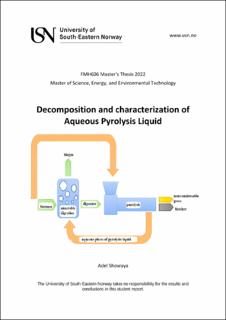Decomposition and characterization of Aqueous Pyrolysis Liquid
Master thesis
Permanent lenke
https://hdl.handle.net/11250/3006843Utgivelsesdato
2022Metadata
Vis full innførselSamlinger
Sammendrag
Pyrolysis is one of the fastest methods for depolymerizing biomass macromolecules (i.e., cellulose and hemicellulose) into smaller molecular fragments (i.e., hydroxy acetaldehyde). Pyrolysis of biomass results in a two-phase liquid, the aqueous phase has a low heating value and a high-water content (aqueous pyrolysis liquid, APL).
Anaerobic digestion (AD) may be the simplest method of producing a biofuel (methane, CH4) from APL. In this project, three types of APL (APL 500, APL 600, and APL 700) obtained from Scanship AS, are evaluated by carrying out a batch experiment to understand their CH4 potential and to understand. We studied the characterization and decomposition methods of APL as well. Experiments on APL including electrochemical treatment, acid esterification, BMP test, and FTIR characterization were employed to study the effect of different conditions (e.g., Voltage, Concentration, Temperature) on the decomposition of APL.
